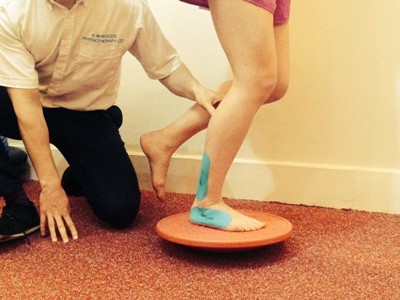At K.M. Woods Physiotherapy, Glasgow, athletes and sports people from varying backgrounds attend our clinics, providing a huge variety of conditions and injuries which we see daily. Below are details of the most common types of sports injuries dealt with regularly at our physio clinics.
Running
Runners, of a leisurely or competitive nature, are possibly the athletic population which most commonly attend our clinics. Endless mileage, often without the ideal conditioning work to compliment these miles, will take its toll on every body and this is where we come in.
The tendency for runners to undertake running as their sole sport, rather than including some forms of cross training in their exercise regime, if the most typical reason seen to underpin running injuries. While consistent running will lead to cardiovascular fitness, and is also brilliant for mental heath, this lack of training variety fails to develop other components fitness, mainly strength and mobility/flexibility. This lack can predispose to irritation an poor biomechanics as we run, resulting in restricted training and a trip to K.M. Woods Physiotherapy!
Conditions most commonly treated are (front of knee) runner’s knee (patellofemoral syndrome), Achilles tendonitis, plantar fasciitis, IT band syndrome, & shin pain (often incorrectly diagnosed as the non-specific umbrella term “shin splints”).
Running biomechanics & training programme design are also an issue closely assessed when treating any running-induced injury. This is especially important around the lower back, pelvis, & hips. Optimal muscle recruitment patterns, optimal muscle length & strength, and optimal strength ration between synergistic muscles must all be ensured so there is efficiency of movement and therefore reduce the likelihood of injury.
Football
Most footballers will attend for physiotherapy for injury treatment and rehabilitation at some point, and we see these players in our clinics each week. Injury can be either acute (where a traumatic injury has been incurred & pain follows) or non-traumatic (no specific trauma is noted) where symptoms or pain or tightness have simply presented over a period of time.
Initial assessment focuses on diagnosing the acute injury where trauma has occurred, or identifying the underlying mechanisms where pain presents without trauma. Initially, treatment focuses on the reduction of acute symptoms, before progressing to rehabilitating the player to their previous level of fitness and undertaking a gradual return to sport programme.
Conditions most commonly treated in the football population are ankle & knee ligament strains, hamstring strains, knee cartilage injuries, groin strains, and hip flexor (front of hip) strains.
Golf
It seems that many of our patients will tolerate pain and discomfort until it begins to interfere with their sporting activities, and this is particularly the case with golfers!!Similar to runners, golfers often develop problems due to a lack of varied exercise, instead simply golfing several time per week. This lack of variety can lead to stiffening of body areas not particularly moved when golfing, & weakening of muscles not challenged by golf.
Treatment often involved hands on manual treatment to help alleviate joint stiffness and soft tissue tightness, before commencing rehabilitation exercises to regain suppleness and strength, maintaining a symptom free state subsequently. A bespoke course of home exercises will also be prescribed, to further develop this more rounded physical resilience.
Conditions most typically seen include golfer’s elbow and tennis elbow (from repeated gripping) thoracic (upper back) stiffness, shoulder pain, and wrist strain with accompanying nerve pain.
Some patient’s have reported physiotherapy as having added 50 yards to their drive distance, this however, is not guaranteed!!
Boxing
At K.M. Woods Physiotherapy, many boxers attend our physiotherapy practice, usually with conditions from one of two sources.
- Conditions seen, arising from over-training, include shoulder irritation, rotator cuff (shoulder muscle) strain, wrist sprain, and neck strain.
- Postural syndrome is also often treated in boxers, where repeated “forwardly active” training in a “forward stance” leads to chest and shoulder tightness, a forward neck position, and an increased kyphosis (curve) in the upper back (thoracic spine).
Treatment focuses on treating any acute injury, while also addressing issues of this postural syndrome, typically with mobility work and rehabilitation of the shoulder and upper back muscles.
Dancing
K.W. Woods Physiotherapy has become the primary clinic for many of the largest dance companies based in Glasgow & the West of Scotland, having been dealing with many of these companies for in excess of 20 years. Professional, amateur, & youth dancers attend our clinics regularly, with a mixture of dance styles catered for – Highland, Irish, ballet, contemporary, hip hop etc.
This long term association has led to our therapists becoming highly skilled in dealing with the specific demands placed on dancers. Knowing the pressures placed on our patients when dancing either in rehearsals or shows, our therapists strive to treat symptoms while enabling the patient to keep dancing, if possible. Various strategies are used in conjunction with clinical treatment to achieve this, including kinesiotaping, the use of specialist shoe insoles etc.
Conditions often treated and rehabilitated amongst the dancing population include metatarsalgia, pain at the front of the knee, plantar fasciitis, ankle sprain, Achilles tendonitis, and rotator cuff (shoulder) strain.
Gym Training
Many patients attend our clinics with injuries presenting as a result of gym training, be it weight-lifting, class-based exercise, swimming, or floor-based exercise. In such an instance, having addressed the acute pain and symptoms, the underlying cause of the symptom presentation is identified, and subsequently addressed. This will often include advising changes of training programmes, or correcting training techniques.
Conditions often seen in such patients include low back pain, shoulder impingement, muscle spasm, hip & knee pain, and muscle strain.

